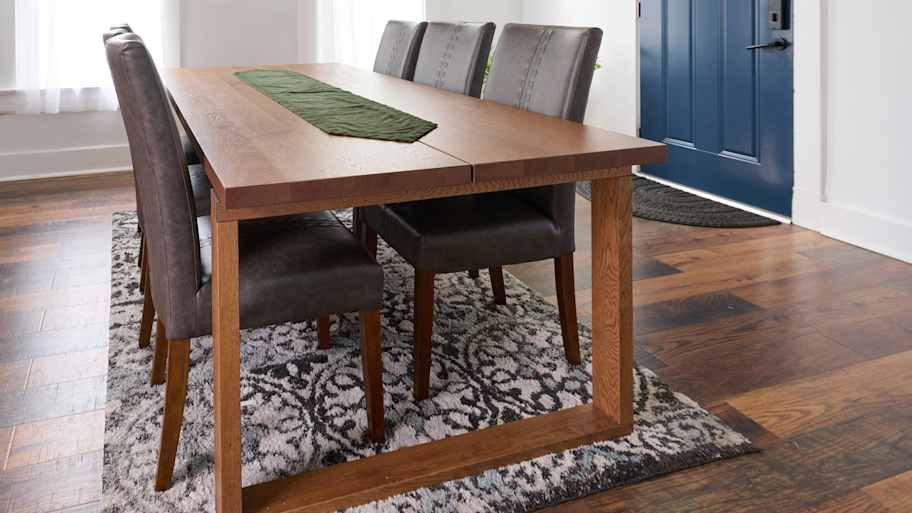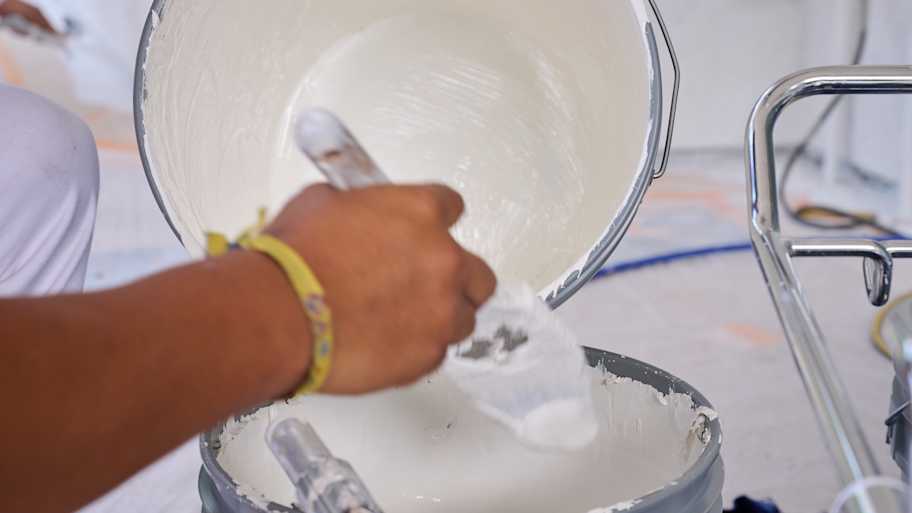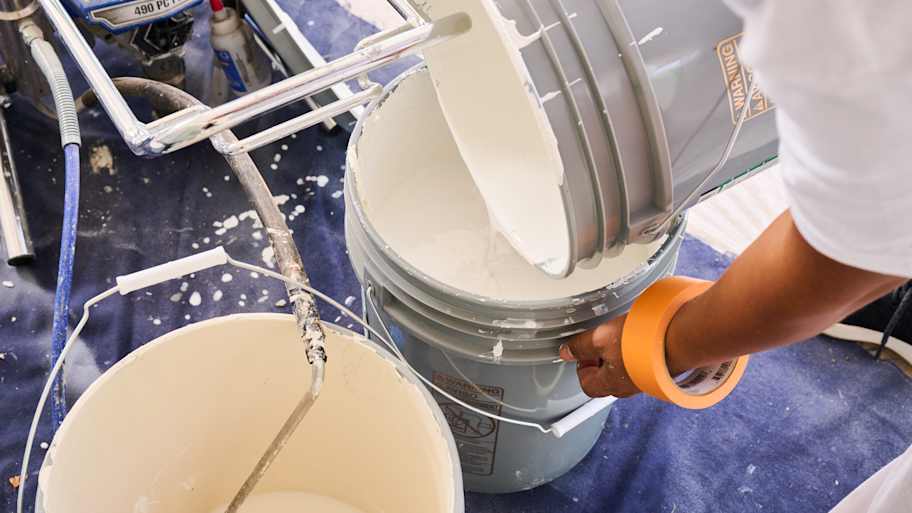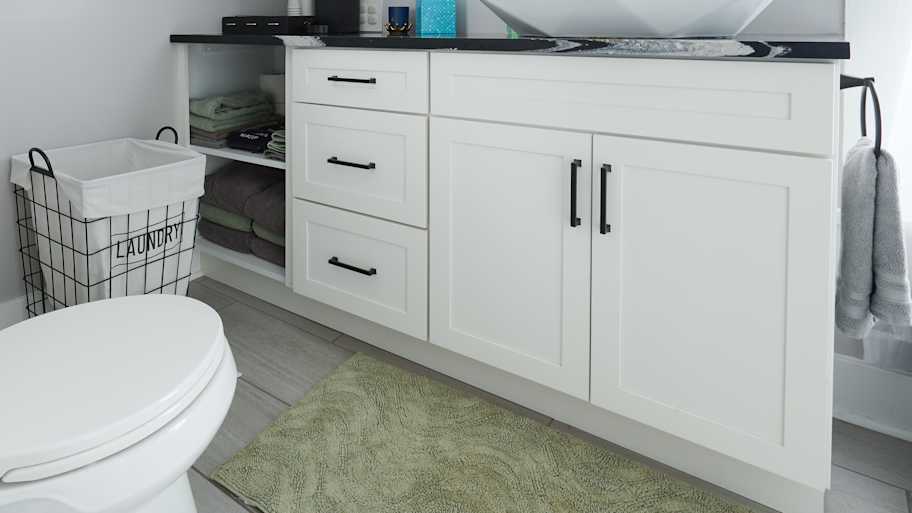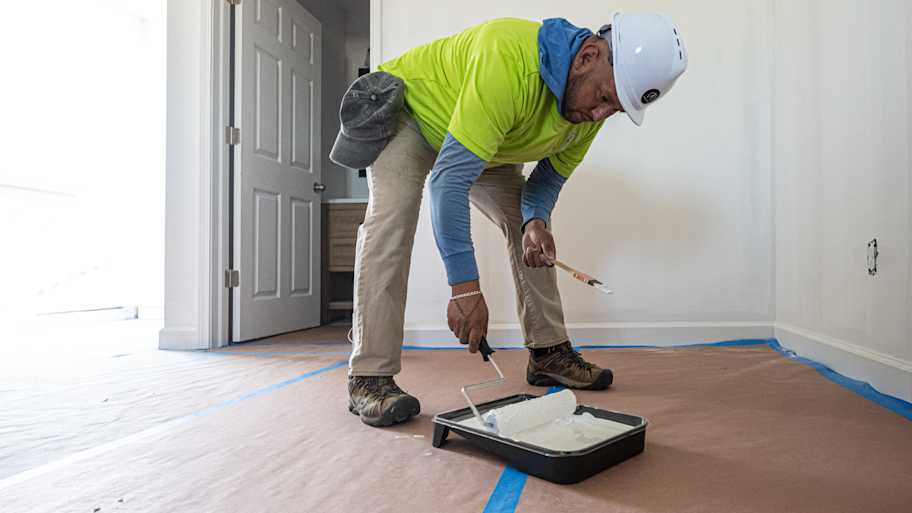How Much Does It Cost to Paint a Bathroom? [2025 Data]
The average cost to paint a bathroom is $300, and prices range between $200 and $500 depending on size, layout, paint type, and more.


The average cost to paint a bathroom is around $300, but your total could fall anywhere between $150 for a small bathroom with minimal prep work and $900 for a primary bathroom with a larger footprint. The size and complexity of the bathroom ultimately determine how much painters will charge.
Here's a rundown of how much you can expect to pay for the average bathroom paint upgrade.
Bathroom Painting Cost Factors
Labor is often the biggest cost component when painting a bathroom with the help of a pro. However, everything from the type of paint you choose to the state of your bathroom walls can also influence the price.
Bathroom Size
Most contractors prepare cost estimates based on a bathroom's size and layout. In most cases, you’ll pay between $2 and $6 per square foot for a professional to paint your bathroom.
Here's a general idea of what you can expect to pay for some common bathroom dimensions.
| Bathroom Size (Sq. Ft.) | Cost Range |
|---|---|
| 35 | $70–$210 |
| 40 | $80–$240 |
| 50 | $100–$300 |
| 80 | $160–$480 |
| 100 | $200–$600 |
For comparison, the average square footage of a half bathroom or powder room is around 20 to 25 square feet. The average square footage of a three-quarter bathroom without a tub is around 35 to 40 square feet. Most primary bathrooms range from around 50 to 100 square feet or more. In some larger homes, primary bathrooms can be more spacious, with separate shower and bathtub areas, dual vanities, and additional features, such as a dressing area or walk-in closet.
Type of Feature
The cost per square foot to paint a bathroom will increase if you want surfaces other than your walls painted, too. If you plan on painting the baseboards, trim, and ceiling, expect your total to fall somewhere between $3 to $8 per square foot.
Here are the typical price ranges for other bathroom items people commonly ask pros to paint.
| Feature | Cost to Paint |
|---|---|
| Baseboards | $1–$4 per linear foot |
| Bathtub | $440 |
| Cabinets | $7–$15 per sq. ft. |
| Ceiling | $0.50–$5 per sq. ft. |
| Countertop | $200 |
| Door | $150 |
| Shower | $150–$300 |
| Toilet | $100 |
| Trim | $1–$6 per linear foot |
Number of Fixtures
While it may seem strange, the number of fixtures in a bathroom can affect how much it costs to paint the room. Fixtures require extra taping, preparation, and diligence, but they also reduce the surface area that your painter actually needs to address. Often, larger fixtures like showers will cut down on costs.
While painters can generally use specialized techniques to get around fixtures, there may be some cases where a toilet or sink needs to come out in order to paint behind it. In those cases, labor costs would increase unless you’re removing the fixture yourself.
Paint Type
The cost to paint a bathroom usually falls between $200 and $500 for labor and materials, but asking for mildew-resistant paint can add about $100 to the job total. If you're looking for a high-end mildew-resistant paint that's also washable, the cost could easily go up by $200. However, given the humidity levels that a bathroom is subject to, asking for specialized paints can be worth the price to increase the longevity of the project.
Your chosen type of paint finish for your bathroom can also change the price. Semi-gloss is a great option for bathrooms since it has an uncanny ability to withstand humidity and repel moisture. Higher sheen levels typically come with a slightly higher price tag, with high-gloss and semi-gloss paints costing the most (as opposed to the more wallet-friendly but less durable matte and eggshell paints).
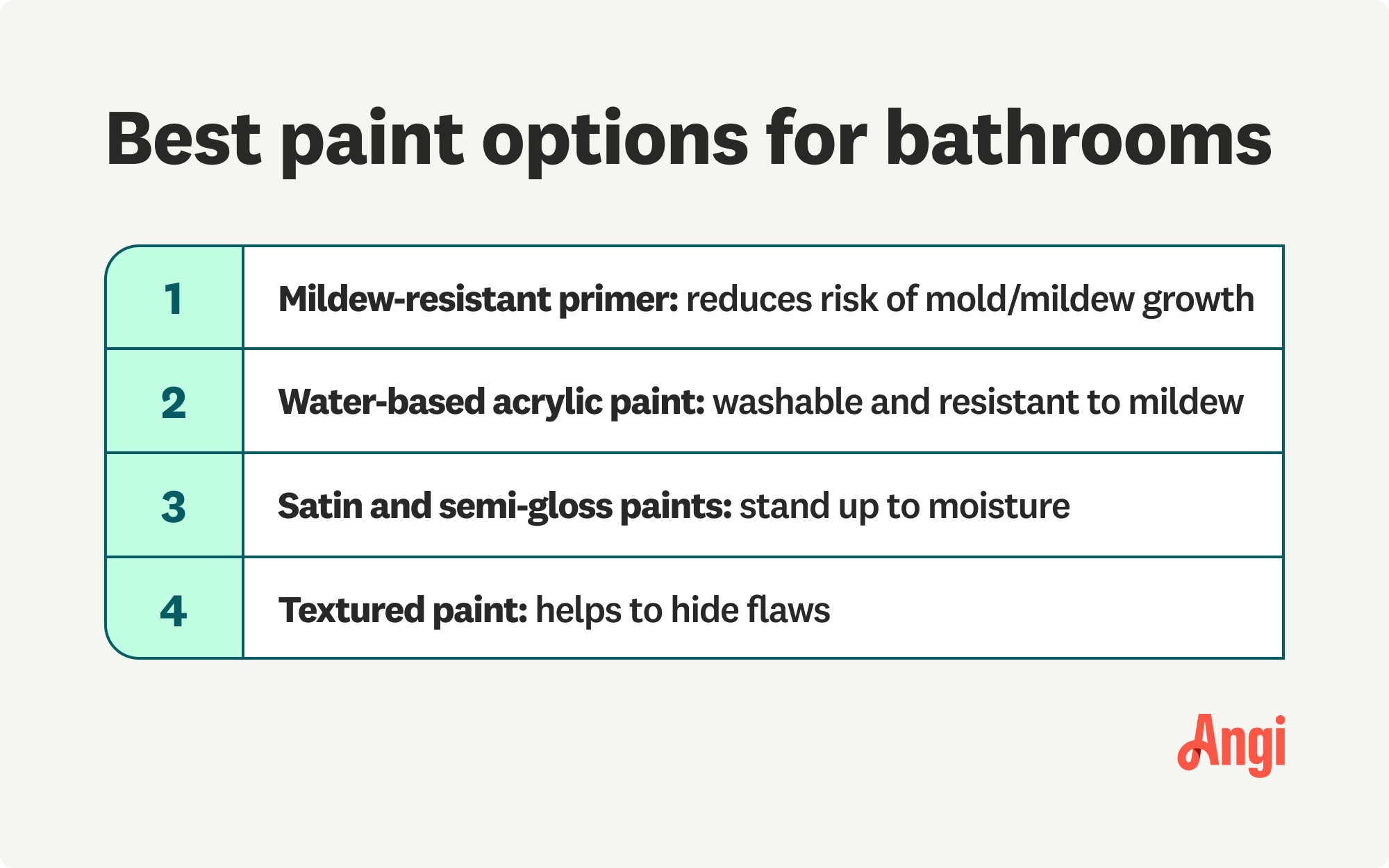
Textured Bathroom Walls
If you want textured bathroom walls, expect the overall price to fall between $4 and $7 per square foot. Texturing is a process that combines different painting techniques to create a sand, popcorn, or knockdown effect on your walls. Texturing can be a good choice if you're trying to cover up wall blemishes that will be obvious with a smooth finish, and it can also give your bathroom some depth.
If you want to remove existing textured walls, you’ll also need to pay more. Removing texture from walls significantly increases the labor required, which drives up labor costs. You may pay anywhere between $1.10 and $1.30 extra per square foot just to smooth out those lumpy, bumpy surfaces you’ve always wanted to remove.
Homes built before 1978 may contain lead-based paint, which can be hazardous to your health when it deteriorates. Have a qualified professional remove any lead paint if it begins to chip or peel.
Repairs
If any part of your bathroom wall is damaged, your painter may need to do some repair work. While most homeowners spend between $60 and $200 to repair minor holes, the cost can get hit $700 or more if there’s major water damage that requires partial drywall replacement and more extensive repairs.
Bathroom Layout Complexity
The layout of your bathroom will partially determine how much prep work is required before your professional gets started, which can affect labor costs. A simple, rectangular floor plan will typically cost closer to $200, while a complex floor plan with closets and multiple corners and bump outs can push your total closer to $500, even for a standard bathroom size.
Lead or Mold Removal
You might need to consider removing hazardous lead paint if your bathroom was last painted prior to 1978. In most cases, you have two options: removing and replacing the drywall or encapsulating the lead paint with a new coat. In either case, your bathroom painting costs will increase since your professional will need to be more cautious during the project and use the appropriate protective gear.
Bathrooms are also prone to mold growth due to the humidity. If you or your painter find mold, you can either cut out and replace the affected drywall, or you can encapsulate it using a stain-blocking paint. In either case, more labor and more protective gear are required, so your total price will be a bit higher.
Labor
Somewhere between 50% and 90% of your total will go toward labor, or between $100 and $800. Your labor costs depend on the layout and complexity of your bathroom, prep work required, and whether or not there are any safety concerns your professional first has to deal with, like lead paint or mold.
DIY vs. Hiring a Pro to Paint Your Bathroom

With the cost of a gallon of paint ranging from $15 to $80, you can get away with a DIY bathroom painting project totaling around $200 in most cases. This estimate includes one to two gallons of paint and basic tools and other painting supplies, like a brush and roller, painter’s tape, and drop cloths. You’ll save between $100 and $800 on labor if you do the work yourself.
While doable, this DIY project can be challenging if your bathroom has tight corners or fixtures that are close to the wall. Many people find it difficult to get a clean, crisp appearance without hiring a professional. Due to the high moisture levels of a bathroom, using the wrong technique can put your bathroom walls at risk for cracking, peeling, and mildew, as well.
"Painting over a surface that has grease or dust build up can cause the paint to apply unevenly, leading to a bubbly or rough texture with clear visible imperfections."
— Gregory Pittman, Director of Commercial Painting Services at Five Star Painting
For the best results, especially if you need patchwork, mold abatement, or lead paint encapsulation done, we recommend hiring a local interior painting company to get the job done.
Cost of Common Bathroom Painting Add-Ons
If you're hiring an interior painter to give your bathroom walls new life, you might want to consider freshening up some other features in the room. These common add-ons can help highlight your new paint job and increase the resale value you see from fresh paint (or just increase your enjoyment of the space).
Cost to remove wallpaper: $1–$4 per square foot
Cost to install a new sink: $200–$700
Cost to replace a bathroom vanity top: $400–$4,300
Cost to add heated floors: $1,700–$6,000
Cost to replace a bathtub: $1,000–$9,000
Tips to Reduce the Cost to Paint a Bathroom
There are a few things you can do to help keep bathroom painting costs as affordable as possible.
Do the prep work yourself. Cleaning the walls with mild soap and warm water will cut down on the time your pro spends on your project, saving you some additional labor costs. If you’re experienced with drywall repair, consider smoothing out the surface before your pro arrives, too.
DIY wallpaper removal. Are you refreshing your bathroom by replacing wallpaper with crisp paint? Spending a few hours on a Saturday removing the wallpaper can help you save on the cost to paint your bathroom.
Choose the right paint. Picking a paint that will resist mold growth and stand up to humidity will usually cost more upfront, but you’re likely to save money over time on redoing the work since it will stand up better to the conditions in your bathroom.
Remove fixtures that are in the way. Rather than having your painter move the toilet or vanity, consider doing it yourself, if you’re comfortable with it. This will cut down on labor costs once your pro arrives.
Frequently Asked Questions
Generally, you should paint your bathroom every three to four years. Seven years is usually the maximum time you should allow between refreshes. How often you should repaint your bathroom depends on the type of material you used on the walls or ceiling, the average moisture and humidity level in the room, and the quality of the paint.
Most bathroom walls will require two coats of paint, as this ensures proper coverage. If you’re painting over a darker color with a lighter color, you may need additional coats. If you’re just refreshing with the same shade, one coat of paint is usually fine. It’s a good idea to put down one to two coats of primer before painting to ensure the best results. This can also cut down on the need for additional coats if you’re painting over a darker color.
Yes, washable bathroom paint is widely available. Manufacturers specially formulate washable bathroom paint to resist damage from frequent cleaning and scrubbing, making it ideal for high-traffic areas like bathrooms. This type of paint generally comes with a semi-gloss or satin finish that you can easily wipe clean with a damp cloth. Additionally, because washable paint has more binding agents than regular paint, it tends to be more durable and lasts longer after application.
Painting behind a toilet requires extra attention and care, as the area is often tight and uncomfortable to reach. First, you should use painter's tape to seal off any areas that you don’t want to get paint on, and use a drop cloth on the floor. Then, use a small roller brush or foam brush to apply the paint, making sure to spread it evenly around corners and tight areas. For the best results, allow the paint to dry in between coats. Finally, after you have finished painting and allowed your work to dry completely, remove the painter’s tape carefully.
